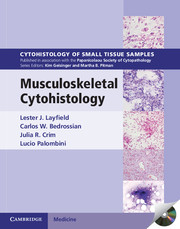Book contents
- Frontmatter
- Contents
- 1 Principles and practice for biopsy diagnosis and management of musculoskeletal lesions
- 2 Ancillary techniques useful in the evaluation and diagnosis of bone and soft tissue neoplasms
- 3 Spindle cell tumors of bone and soft tissue in infants and children
- 4 Spindle cell tumors of the musculoskeletal system characteristically occurring in adults
- 5 Giant cell tumors of the musculoskeletal system
- 6 Myxoid lesions of bone and soft tissue
- 7 Lipomatous tumors
- 8 Vascular tumors of bone and soft tissue
- 9 Pleomorphic sarcomas of bone and soft tissue
- 10 Osseous tumors of bone and soft tissue
- 11 Cartilaginous neoplasms of bone and soft tissue
- 12 Small round cell neoplasms of bone and soft tissue
- 13 Epithelioid and polygonal cell tumors of bone and soft tissue
- 14 Cystic lesions of bone and soft tissue
- Index
13 - Epithelioid and polygonal cell tumors of bone and soft tissue
Published online by Cambridge University Press: 05 September 2013
- Frontmatter
- Contents
- 1 Principles and practice for biopsy diagnosis and management of musculoskeletal lesions
- 2 Ancillary techniques useful in the evaluation and diagnosis of bone and soft tissue neoplasms
- 3 Spindle cell tumors of bone and soft tissue in infants and children
- 4 Spindle cell tumors of the musculoskeletal system characteristically occurring in adults
- 5 Giant cell tumors of the musculoskeletal system
- 6 Myxoid lesions of bone and soft tissue
- 7 Lipomatous tumors
- 8 Vascular tumors of bone and soft tissue
- 9 Pleomorphic sarcomas of bone and soft tissue
- 10 Osseous tumors of bone and soft tissue
- 11 Cartilaginous neoplasms of bone and soft tissue
- 12 Small round cell neoplasms of bone and soft tissue
- 13 Epithelioid and polygonal cell tumors of bone and soft tissue
- 14 Cystic lesions of bone and soft tissue
- Index
Summary
INTRODUCTION
This category of neoplasms represents a diverse group of morphologically similar but biologically heterogenous soft tissue and bone neoplasms characterized by an epithelioid or polygonal cell morphology. Numerically, this is the least common group of neoplasms with only granular cell tumor and synovial sarcoma occurring with significant frequency. Synovial sarcoma represents approximately 5–10% of all soft tissue sarcomas and granular cell tumor is a relatively common benign neoplasm.
The characteristic or predominate cell type in each of these neoplasms has an ovoid or polygonal shape in smear preparations. In most of these neoplasms, a similar shape is demonstrable in H&E stained histologic sections yielding a superficial resemblance of these cells to epithelial cells. In the case of synovial sarcoma, the polygonal or ovoid shape seen cytologically appears to be a result of smearing artifact and a more spindle shape characterizes synovial sarcomas histologically. Some members of this cytomorphologic category demonstrate an accepted direction of differentiation such as granular cell tumor which shows neural differentiation and Langerhans cell histiocytosis which demonstrates histiocytic differentiation. Other lesions such as synovial sarcoma, epithelioid sarcoma, and extrarenal rhabdoid tumor represent sarcomas of uncertain type and lack a definitive direction of differentiation. Despite lack of a clear direction of differentiation for some of these neoplasms, characteristic immunohistochemical and molecular profiles exist for synovial sarcoma, clear cell sarcoma of soft parts, Langerhans cell histiocytosis, granular cell tumors, and extrarenal rhabdoid tumors.
- Type
- Chapter
- Information
- Musculoskeletal Cytohistology , pp. 275 - 302Publisher: Cambridge University PressPrint publication year: 2000

